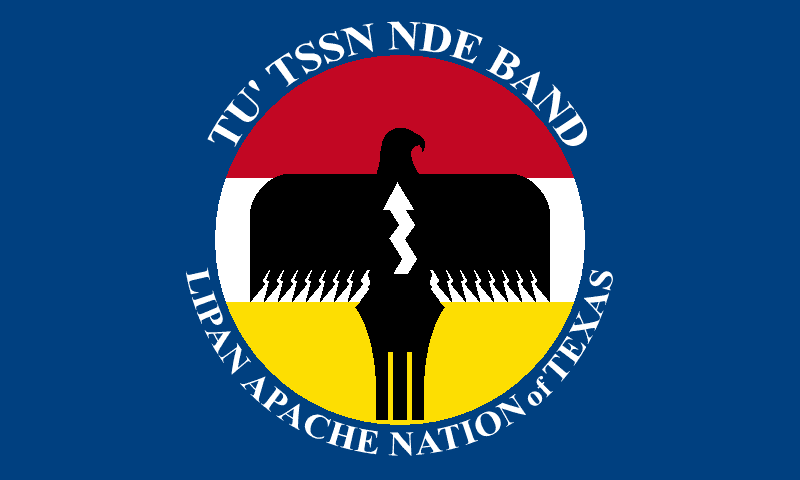Different Native American groups in the Southwestern United States share the name “Apache” (pronounced uh·pa·chee), including the Salinero, Plains, Ndendahe, Mimbreo, Mescalero, Lipan, Jicarilla, Chiricahua, and Western Apache people. The Apache and Navajo are two tribes that are closely linked to each other and are thought to have originated in Canada. The Apache, a North American Indian tribe, played a pivotal role in the development of the Southwestern United States in the second half of the 19th century.

Flag of the Lipan Apache Nation of Texas
© – License
Name
Spanish conquistadors first met the Apache in the Texas Panhandle; thus, the name has Spanish origins. It is thought that the name “Apacu” comes from the Zui term for “enemy,” “ápachu,” which was afterward transcribed into Spanish. In the 1620s, when referring to individuals in the Chama region (a village in New Mexico), the Spanish first used the title Apachu de Nabajo (Navajo). Most people believe Apache originated from the Zuni word apau, which means “Navajos.” Apache speakers refer to both themselves and their society as “Indé,” which translates to “person” In their own language, the Navajo call themselves Diné.
Location
Western Texas; northwestern, southwestern, and eastern New Mexico; southeast Colorado; Sonora states in Mexico; and east-central and southeast Arizona were all part of the Apache dominion before the Spanish colonized it. It also encompasses southeast Texas and the eastern part of the state in the United States. However, Apache forebears didn’t start showing up in the Southwest until at least 1100 CE. It seems likely that the Apachean peoples migrated south from the Arctic because their languages are indisputably a branch of the Athabaskan language family. Except for the Navajo, all other Athabaskan-speaking tribes had their historical homelands in what is now western Canada.
As late as the year 1700, Plains Apache farmers could be found settling along the Dismal River in present-day Kansas. Eventually, though, the Apache opted for a more nomadic existence, moving from place to place primarily by horse. Once the horse and gun markets converged in the central Plains around 1750, traditionally nomadic groups such as the Comanche dramatically increased their guerrilla-style raiding. The remainder of the Plains Apache fled to the south and west after coming under heavy attack.
Population
About 100,000 people in the early 21st century could trace their ancestry back to the Apache people. There are still about 30,000 Apache Indians alive today, mostly living in Arizona and New Mexico. There are currently 13 distinct Apache tribes across the United States. This includes five in Arizona, three in Oklahoma, and five in New Mexico. The Apache Indians are a federation of these tribes.
Beliefs
Many Apache people believed in the power of nature and the supernatural. They believed nature explained everything. Ussen is the Apache’s Creator and existed before the cosmos. In Apache spirituality, the Creator constructed the Earth in four days. The four cardinal directions, along with singing, dance, and the spiritual drum all represent the number four, which is sacred to them. They also believe in Earth, the moon, the sun, and mountains as spiritual conduits. Spirits are often contacted through ritual like dances. Therapeutic, rain-requesting, and puberty-celebrating dances are also performed. Apaches believe water is powerful too. According to legend, frequent baths cleanse evil spirits.
Shamans or traditional healers are tribe members with special healing talents. These distinctive religious leaders may use rare herbs and remedies to heal tribal people. Apache women often lead families and the Apache community. The Apache believe puberty strengthens girls’ authority. Morning dance signifies puberty and prepares girls for motherhood and maturity. Once a four-day event, it’s now frequently two. After the ceremony, Apache females are said to have immense healing and rain-causing ability for four days.
Culture
Except for the Kiowa Apache, which joined the Kiowa tribal circle, the Apache had no unified tribe organization. Instead, the band was the primary political and raiding unit. Several bands could also be unified under one informal leader. However, chief status had to be earned, not inherited. After moving to the Southwest, the Apache built a diverse economic system that comprised farming, hunting, and trading with and robbing Pueblo villages. The Jicarilla Apache band hunted bison and farmed corn and other crops. The Lipan, previously a Jicarilla band, abandoned farming for a nomadic lifestyle. The Plains tribes’ bison and corn-based economies influenced the Mescalero, whose major food source was mescal, which explains the name Mescalero.

This traditional Apache wickiup, or dwelling, shows the ingenuity of construction and resourcefulness of the people.
© – License
Language
Kiowa Apache was a Southern Athabaskan language spoken by the Plains Apache, who was also known as the Apache Tribe of Oklahoma. They traditionally lived in and around Anadarko in southwestern Oklahoma. This language has been lost after the passing of its last known native speaker in 2008, Alfred Chalepah, Jr.
These days, Eastern and Western Apache are the only living Southern Athabaskan tongues. The eastern Apache languages are Navajo, Mescalero, Lipan, Kiowa Apache, Jicarilla, Chiricahua, and Western Apache encompasses a wide range of dialects, including but not limited to the Yavapai Apache, WMA, San Carlos, Northern and Southern Tonto, and Cibecue, languages.
Up Next
The photo featured at the top of this post is © – License / Original
Sources
- , Available here: https://apachetribe.org/
- , Available here: http://www.bigorrin.org/apache_kids.htm
- , Available here: https://thehistoryjunkie.com/the-apache-indians/
Thank you for reading! Have some feedback for us? Contact the AZ Animals editorial team.






